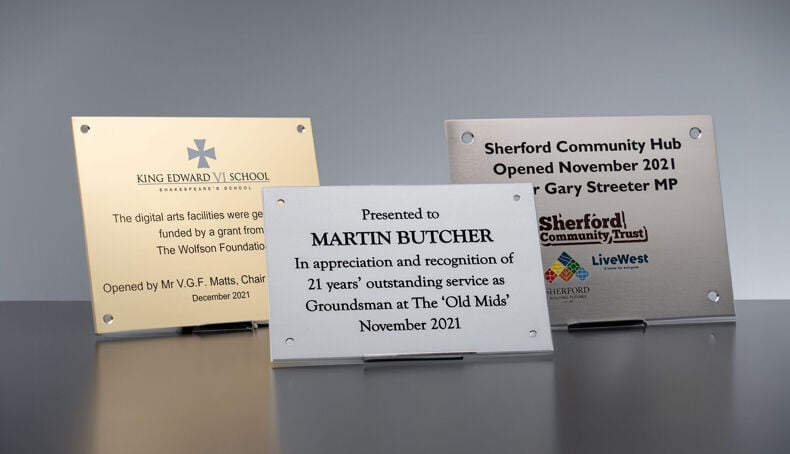On many of our plaques, nameplates and awards, you’ll be faced with a few options on which material best suits your needs. Three of our main materials used across many of our products are either Brass, Aluminium, or Stainless Steel. But what are the differences?
Brass
Brass is an alloy created by combining copper and zinc. It’s often a top choice of metal for decorative objects such as plaques, plates and trophies because of its resemblance to gold. It is also highly malleable and durable, and this versatility makes it a top pick for many engineered components and instruments across all industries. The main downside to brass is its susceptibility to black tarnish from oxidisation of the metal, meaning that decorative pieces like nameplates and plaques often require a lot of polishing and upkeep to keep it sparkling.
Stainless Steel
Stainless steel is a low carbon steel which contains chromium at 10% or more by weight. This chromium content makes the metal highly resistant to rust and corrosion. At Brunel Engraving we use 316 Marine grade stainless steel for our plaques, which also won't tarnish or rust when subjected to wet conditions. Stainless steel is also very strong and hard-wearing, maintaining shape and strength under high heats, although different types do have varying degrees of ductility depending on its nickel content. While more expensive than traditional carbon steel, these stainless properties make it a very popular choice for both practical and decorative metal pieces.
Aluminium
Aluminium is a lightweight metal which is soft and malleable. Due to its softness, it can be rolled into sheets and is often used for nameplates and commemorative plaques. Its also often used in aeroplane parts due to it being so lightweight. While Aluminium looks wonderful with its silvery-white appearance, the main attracting feature of aluminium is its great strength to weight ratio. While pound for pound it’s far weaker than steel, more aluminium can be used while remaining lighter and cheaper than steel. Anodised aluminium is also very corrosion resistant making it a favourable all-rounder.
Now that we have looked at the qualities of these three metals, how do they compare to one another?
Brass vs Stainless Steel
Brass is commonly known for being an traditional material that can tarnish when exposed to external elements, stainless steel is highly resistant to rust and corrosion even when exposed to wet conditions. Both metals are hard-wearing, but brass is known for being malleable and versatile while stainless steel is prized for its strength and resistance to high temperatures. We recommend using brass for highly decorative plaques and requires cleaning regularly with a polish to maintain its appearances, and stainless steel for signs which need to endure harsher conditions such as coastal environments.
Brass vs Aluminium
Brass is a long-lasting durable material, ideal for hard-wearing items in traditional settings and is often supplied in a polished finish. In comparison, aluminium is a much softer and more malleable metal with the advantage of being extremely lightweight. Unlike brass, which tarnishes, anodised aluminium is resistant to corrosion and will continue to look clean and bright for a long time. Both sheet aluminium and brass can be used for engraved nameplates, plaques and signs - but we recommend using brass for more decorative occasions.
Stainless Steel vs Aluminium
Aluminium is lighter, softer and more affordable than tough, heavy-duty stainless steel. Whilst aluminium can be manipulated and rolled into sheets, stainless steel is strong and will maintain its shape when subjected to stress and heat. As the name suggests, stainless steel is highly resistant to corrosion, rust, tarnishing and discoloration - and so is anodised aluminium. This means that both can be used for plaques, signs and name plates intended to be used outside in the rain and wind. If cost is a consideration, aluminium is the cheaper option, whilst still looking stylish and sophisticated. If you need a long-lasting memorial plaque, stainless steel is highly durable and will last for years to come.


